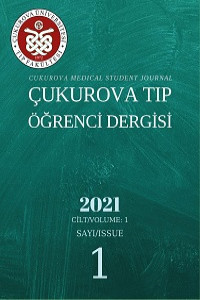Online eğitimin göz sağlığına olan etkisi
COVID-19, online eğitim, göz, göz sorunları
The effect of online education on eye health
COVID 19, online education, eye, vision problems,
___
- 1. Yıldırım A. Dijital çağda dijital pandemi: Türkiye’de Covid-19 gündemi. Intermedia International E-journal. 2020;7:381-401.
- 2. Saw SM, Chua WH, Hong CY, Wu HM, Chan WY, Chia KS et al. Nearwork in early-onset myopia. Invest Ophthalmol Vis Sci. 2002;43:332-9.
- 3. Ip JM, Saw SM, Rose KA, Morgan IG, Kifley A, Wang JJ et al. Role of near work in myopia: findings in a sample of Australian school children. Invest Ophthalmol Vis Sci. 2008;49:2903-10.
- 4. Brody JE. Millions at risk of computer vision syndrome. ET Healthworld. (May 31, 2016). https://www.giftechs.com.ng/2016/05/millions-at-risk-of-computer-vision.html. Retrieved May 10, 2021
- 5. Daien V, Pérès K, Villain M, Colvez A, Delcourt C, Carrière I. Visual impairment, optical correction, and their impact on activity limitations in elderly persons: the POLA study. Arch Intern Med. 2011;171:1206-7.
- 6. Hong T, Mitchell P, Burlutsky G, Gopinath B, Liew G, Wang JJ et al. Visual impairment and depressive symptoms in an older Australian cohort: longitudinal findings from the Blue Mountains Eye Study. Br J Ophthalmol. 2015;99:1017-21.
- 7. Mutti DO, Mitchell GL, Hayes JR, Jones L, Moeschberger ML, Cotter SA et al. Accommodative lag before and after the onset of myopia. Invest Ophthalmol Vis Sci. 2006;47:837-46.
- 8. Klein BE, Klein R, Lee KE, Cruickshanks KJ. Performance-based and self-assessed measures of visual function as related to history of falls, hip fractures, and measured gait time. The Beaver Dam Eye Study. Ophthalmology. 1998;105:160-4.
- 9. Ivers RQ, Mitchell P, Cumming RG. Sensory impairment and driving: the Blue Mountains Eye Study. Am J Public Health. 1999;89:85-7.
- 10. Sherrod CE, Vitale S, Frick KD, Ramulu PY. Association of vision loss and work status in the United States. JAMA Ophthalmol. 2014;132:1239-42.
- 11. Porcar E; Pons AM; Lorente A. Visual and ocular effects from the use of flat-panel displays. Int J Ophthalmol. 2016;9:881–5.
- 12. Izquierdo NJ; Townsend W. Computer vision syndrome. https://www.webmd.com/eye-health/computer-vision-syndrome. Retrieved May 10, 2021.
- 13. Stringham J, Stringham N; O’Brien K. Macular carotenoid supplementation improves visual performance, sleep quality, and adverse physical symptoms in those with high screen time exposure. Foods. 2017;6:47..
- 14. Rosenfield M, Li RT, Kirsch NT. A double-blind test of blue-blocking filters on symptoms of digital eye strain. Work. 2020;65:343-8. 4
- Yayın Aralığı: Yılda 2 Sayı
- Başlangıç: 2021
- Yayıncı: Çukurova Üniversitesi
Online eğitimin göz sağlığına olan etkisi
Fırat ONGUN, Duygu DUMAN, Ahmet IŞIK, Ersin NAZLICAN
Kilo vermede kullanılan bitkisel ürünlerin ve diyet takviyelerinin hepatotoksik etkileri
Başak ÇOLAK, Safiye ÖZCAN, Hikmet AKKIZ
Çukurova Tıp Öğrenci Dergisi ilk sayısıyla şimdi yayında
Çukurova Üniversitesi Tıp Fakültesi öğrencilerinin ABO kan grubu sistemine göre dağılımları
Hamid BİRDAL, Nur Hilal KIRBIYIK, Raziye UĞUZ, Beyaz Tuğçe KAHRAMAN, Ayfer BOĞA PEKMEZEKMEK
Yeni bir başlangıç: Çukurova Tıp Öğrenci Dergisi
